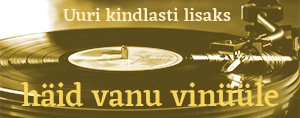Electronic Publishing on CD-ROM, Klõpsa siia , et näha täielikku loendit! Electronic Publishing on CD-ROM, O'Reilly Media 1996 | vanaraamat. ee
Müügil 54590 raamatut
Ahvatlevad sooduspakkumised Ajalugu, militaar ja punanurk Ehitus, tehnika Elulood, memuaarid Eneseabi, psühholoogia, psühhiaatria, pedagoogika, lastekasvatus Esoteerika, religioon Filmikunst, teater, näidendid Filosoofia, loogika Fotograafia, filmitehnika Ilu, mood Ilukirjandus Infotehnoloogia, programmeerimine ja internet Kalandus, jahindus, mesindus Kalendrid, märkmikud KINKEKAART Kodu ja aed Kokaraamatud Kultuur Kunst, arhitektuur Käsiraamatud, teatmikud ja õppematerjalid Käsitöö Laste- ja noortekirjandus Loodus Luule Majandus, poliitika Meditsiin, tervishoid Meelelahutus Miniraamatud Muusika, noodid, laulikud Perioodika (temaatiline perioodika vastavates teemades) Postkaardid, vanad fotod Põllumajandus, loomakasvatus Raamatud enne 1944-ndat aastat Raamatud spordist Raamatud teaduslikel teemadel Reisijuhid, reisikirjad Ristsõnad Seiklusjutte maalt ja merelt Telli endale unikaalne eksliibris Vanad nahkköited VINÜÜLPLAADID Võõrkeelne (foreign books) Õigus Ühiskond ja sotsioloogia XXX (seks)
Ostukorv on tühi

Teema: Käsiraamatud, ning teatmikud ja õppematerjalid
Pealkiri: Electronic Publishing on CD-ROM
Autor(id): Steve Cunningham, Judson Rosebush
Kirjastus: O'Reilly Media
Linn:
Aasta: 1996
Originaalkeel:
ISBN: 1565922093, 9781565922099
Lehekülgi: 412
Seisukord: kaaned pisut kulunud, leheservad natuke määrdunud, eksliibris sees, kaasakäiv CD olemas
Mõõdud: 230x233x26 mm
Suurus: tavaformaadist veidi suuremas formaadis, pehmete kaantega
Sisu:
RAAMAT ASUB LAOS, SAADAVAL 3-5 PÄEVA JOOKSUL. Y006
In the past few years, the whole concept of publishing has undergone an enormous transformation. Publishers are no longer limited to paper and ink. Electronic publications can now incorporate text, images, sound, video, and interactive games and simulations. And publishing has become a more democratic activity -- with the explosive growth of both the Internet and CD-ROM technology, more and more people are publishing their own titles.
There has been a huge growth in the CD-ROM installed base and the market for CD-ROM titles. There are tens of millions of CD-ROM drives installed, and the coming Digital Video Disc (DVD) format will bring many more. CD-ROMs have enormous capacity, and they are compact, durable, and inexpensive to manufacture, store, and ship. We're now seeing everything from games to educational products to reference and technical documents being delivered on CD-ROM.
This book looks at the many kinds of electronic publications being produced today. Although it focuses on CD-ROM, the discussion is also relevant to publishing on the World Wide Web. Electronic Publishing on CD-ROM describes examples and alternatives for the design, authoring, manufacturing, marketing, and distribution of CD-ROMs. It covers electronic document authoring systems (e.g., Adobe's Acrobat, Macromedia's Director, Apple's HyperTalk, and more). It discusses traditional and emerging document standards and formats (e.g., SGML, HTML, and Java), as well as physical disc standards (e.g., ISO 9660, HFS). It also provides detailed information on the costs of CD-ROM publishing projects -- staff, manufacturing, and phases of development. In addition, it includes an extensive list of resources and a helpful glossary and bibliography.
Provided with this book is a a CD-ROM full of resources, including the text of portions of the book, in both Acrobat PDF and HTML form; freely available software for document authoring and browsing; demos of CD-ROM titles of various kinds; frequently asked question (FAQ) listings about CD-ROM publishing, data compression, different types of file formats (image, audio, and font formats), JPEG, MPEG, and Java; and much more.
This book is divided into four parts:
Part I, Overview of Electronic Publishing, contains the following:
Chapter 1, Electronic Publications, describes what electronic publications are and why they have become so popular. It discusses the special qualities of electronic documents, touches on a number of emerging technologies, and looks briefly at intellectual property issues for electronic publishing. Chapter 2, CD-ROM and Online Publishing, examines the pros and cons of publishing on CD-ROM and on the Internet. It also looks at hybrid products that take advantage of both publishing models. Chapter 3, Two Electronic Titles, profiles two very different kinds of CD-ROM titles. Isaac Asimov's The Ultimate Robot, is a professionally produced, mass market "edutainment" product, which blends education and entertainment. The electronic version of the Association of Computing Machinery's (ACM's) SIGGRAPH group's conference proceedings is a volunteer-produced technical title. Part II, CD-ROM Development, contains the following:
Chapter 4, Developing a CD-ROM, provides an overview of the CD-ROM development process, from initial product planning through final production of the CD-ROM image. It discusses the staffing that is required for most development projects, and provides cost estimates for several different types of projects. Chapter 5, Designing Electronic Documents, discusses a variety of design issues for CD-ROMs, in areas of overall title navigation, graphics, user interface, sound, digital video, and software. Chapter 6, Authoring Systems, examines what makes a good authoring system for electronic documents and looks at a number of examples of systems being used today, including Director, HyperCard, Acrobat, GainMomentum, Media Tool, and HTML. Chapter 7, Electronic Document Standards, summarizes a variety of standards for electronic documents, in areas of text (e.g., SGML, HTML), page description (e.g., PostScript, PDF), network (e.g., Java, VRML), image (e.g., formats such as BMP and TGA, and compression methods such as RLE and JPEG), digital video (e.g., QuickTime, MPEG), and sound (e.g., MIDI). Chapter 8, CD-ROM Disc Standards, describes the various CD-ROM standards, focusing on the ISO 9660 and HFS specifications. Part III, CD-ROM Manufacturing, Marketing, and Distribution, contains the following: Chapter 9, Manufacturing CD-ROMs, describes the process of manufacturing CD-ROMs, including production timelines, preparing data for manufacturing, and all of the production steps. Chapter 10, CD-ROM Publishing Costs, provides concrete examples of CD-ROM publishing projects and the costs of developing, licensing, producing, testing, printing, mastering, manufacturing, shipping, and marketing. Chapter 11, CD-ROM Marketing and Distribution, provides an overview of approaches to marketing titles to various audiences, and different distribution models for CD-ROMs. Part IV, Appendices, contains the following: Appendix A, Resources, lists resources for organizations that provide CD-ROM hardware, software, and services. The Glossary defines the terms used in this book and in the electronic publishing business. The Bibliography provides references for further reading.
Hind: 26,00 EUR
Teema Võõrkeelne (foreign books) alla viimati lisatud:
Weltatlas. Die Staaten der Erde und ihre Wirtschaft,
Verlag Enzyklopädie Leipzig, 1957, hind: 4,00 eurot
Juhan Smuul, Добрый Заступник моряков (Hea meremeeste Hoidja),
Eesti Raamat, 1984, hind: 8,00 eurot
Светлана Логинова / Svetlana Loginova, Бандитский Ида-Вирумаа (документальный очерк о криминальном мире Эстонии последнего десятилетия) / Bandiitlik Ida-Virumaa ( Banditskii Ida-Virumaa),
LogSve, 2004, hind: 15,00 eurot
Venekeelne raamat,
1990, hind: 4,00 eurot
Venekeelne raamat,
1989, hind: 7,00 eurot
Venekeelne raamat,
1951, hind: 15,00 eurot
Venekeelne raamat,
1970, hind: 9,00 eurot
Venekeelne raamat,
1983, hind: 9,00 eurot
Venekeelne raamat,
1958, hind: 6,00 eurot
Chris Heath, Feel. Robbie Williams,
Ebury Press, hind: 6,00 eurot
Võõrkeelne (foreign books) all on 487 raamatut. Klõpsa siia, et näha täielikku loendit!
Weltatlas. Die Staaten der Erde und ihre Wirtschaft,
Verlag Enzyklopädie Leipzig, 1957, hind: 4,00 eurot
Juhan Smuul, Добрый Заступник моряков (Hea meremeeste Hoidja),
Eesti Raamat, 1984, hind: 8,00 eurot
Светлана Логинова / Svetlana Loginova, Бандитский Ида-Вирумаа (документальный очерк о криминальном мире Эстонии последнего десятилетия) / Bandiitlik Ida-Virumaa ( Banditskii Ida-Virumaa),
LogSve, 2004, hind: 15,00 eurot
Venekeelne raamat,
1990, hind: 4,00 eurot
Venekeelne raamat,
1989, hind: 7,00 eurot
Venekeelne raamat,
1951, hind: 15,00 eurot
Venekeelne raamat,
1970, hind: 9,00 eurot
Venekeelne raamat,
1983, hind: 9,00 eurot
Venekeelne raamat,
1958, hind: 6,00 eurot
Chris Heath, Feel. Robbie Williams,
Ebury Press, hind: 6,00 eurot
Võõrkeelne (foreign books) all on 487 raamatut. Klõpsa siia, et näha täielikku loendit!
Kasutatud raamatud
Alates 1999. aastast järjest täienenud raamatukataloog sisaldab täna üht Eesti kõige hoolikamalt valitud, sisukaimat kollektsiooni, mis pakub raamatusõpradele ehedaimat lugemisrõõmu.
Üle 47 000 väljaande
Kui tüüpilises raamatupoes on tavapäraselt müügil umbes 3000 raamatut, siis Vanaraamatu antikvariaat pakub lugejaile suuremat valikut, sest müüme kasutatud raamatuid erinevatest kümnenditest.
Raamatute tellimine
Kõiki kataloogis müügil olevaid väljaandeid saad mugavalt tellida veebilehe kaudu.
Veebist ostmise juhend
Tellimistingimused
Privaatsustingimused
Kontaktandmed
Biblio OÜ, reg.nr. 10598332,
Raamatupood: Riia 5, Tartu, 51010 Eesti
Veebikataloog: www.vanaraamat.ee
Kontakttelefon (+372) 7 341 901
E-mail:







www.vanaraamat.ee © 2024 Biblio OÜ » Kvaliteetsed kasutatud raamatud








